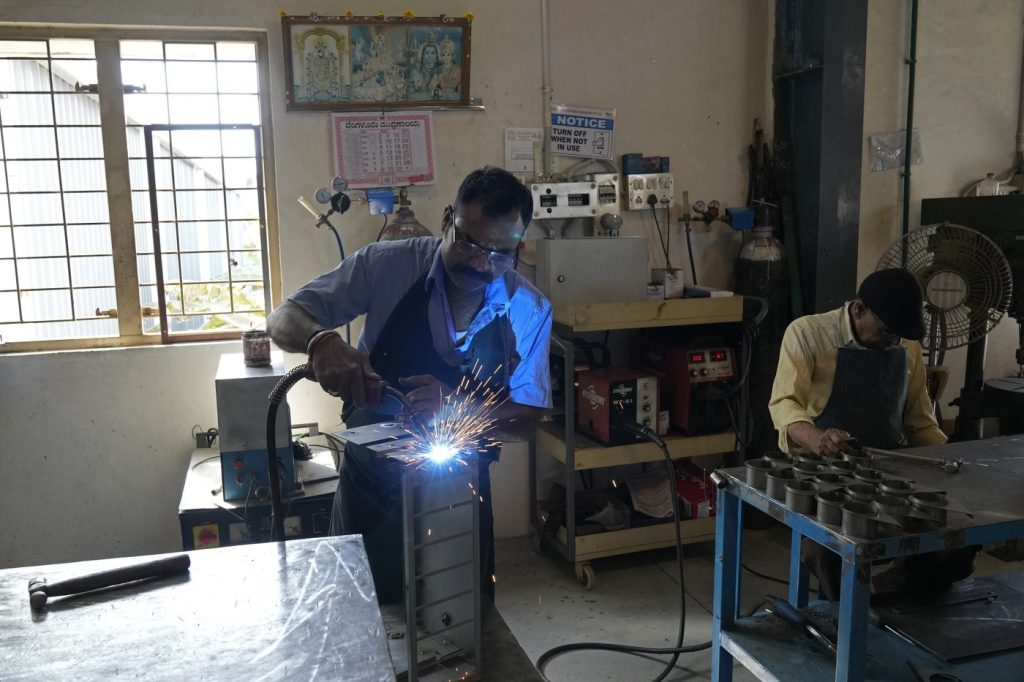BENGALURU, India (AP) — In a dusty suburb of Bengaluru, rows of small factories are engaged in the steel industry, producing various products from car parts to kitchen sinks. Recent announcements by U.S. President Trump regarding the imposition of high trade tariffs on steel imports have garnered unexpected support from some within the Indian steel sector.
Many industry insiders believe that the proposed 25% tariff will discourage companies from countries like China and South Korea from exporting steel to the U.S. Consequently, this could lead to an influx of cheaper steel being dumped in markets like India. B. Praveen, a representative from Sun Techpro Engineering, expressed optimism that his company's profit margins could improve as the cost of steel decreases. He highlighted that businesses like his employ over 200 million Indians and play crucial roles in the economic landscape of the country.
However, the implications of cheaper steel are not universally positive. Naveen Jindal, the president of the Indian Steel Association, has voiced deep concerns about the potential for steel dumping in India, which remains one of the few major markets without trade restrictions. The increased competition could also hinder India's attempts to produce steel more sustainably, as current production methods lead to significant greenhouse gas emissions that contribute to climate change.
India's steel industry is substantial and characterized by high emissions, with a forecasted growth in production from 120 million tons to 300 million tons within the next five years. The burgeoning demand for steel is driven by rapid urbanization and industrial growth within the country. According to the Global Energy Monitor, up to 12% of India's greenhouse gas emissions stem from steelmaking, and this figure could potentially double if the government's production goals are met.
Research analyst Henna Khadeeja noted that Indian steelmakers predominantly rely on coal-based blast furnaces, which are high-emission technologies. Although the Indian government announced a $1.72 billion investment to transition the steel industry towards cleaner production methods, new expansion plans mostly focus on coal-based facilities. Khadeeja emphasized the urgent need for a shift in strategy, advocating for the retroactive decarbonization of steel production once new capacities are established.
The expansion of coal-based facilities may jeopardize India's long-term ambitions in the global steel market, particularly concerning exports to Europe. Easwaran Narassimhan from the Sustainable Futures Collective highlighted that upcoming European carbon taxes will likely dissuade buyers from purchasing steel produced through high-emission methods employed in India. He observed that China’s steel production emits less carbon, suggesting that India must make decisions today that will prevent larger consequences in the future.
India has set ambitious climate targets, aiming to establish 500 gigawatts of clean power by the end of the decade. The nation recently achieved a significant milestone by installing 100 gigawatts of solar energy over the past decade. Moreover, India has aspirations of reaching net-zero emissions by 2070, which entails preventing emissions and/or utilizing methods to remove equivalent amounts of greenhouse gases from the atmosphere.
While Indian steelmakers acknowledge the necessity of reducing emissions, they express concerns regarding the financial implications of transitioning to cleaner methods. Prabodh Acharya, the chief sustainability officer at JSW Group, emphasized the essential nature of steel for societal and economic growth, advocating for a balance between growth, economic viability, and decarbonization efforts.










